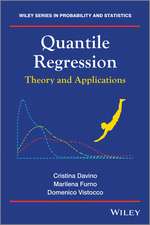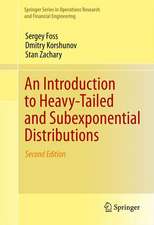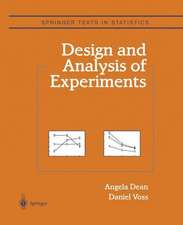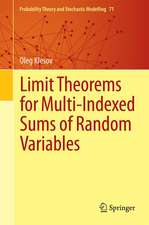The Statistical Analysis of Categorical Data
Autor Erling B. Andersenen Limba Engleză Paperback – 13 dec 2011
Preț: 407.19 lei
Nou
Puncte Express: 611
Preț estimativ în valută:
77.91€ • 81.36$ • 64.34£
77.91€ • 81.36$ • 64.34£
Carte tipărită la comandă
Livrare economică 15-29 aprilie
Preluare comenzi: 021 569.72.76
Specificații
ISBN-13: 9783642788192
ISBN-10: 364278819X
Pagini: 548
Ilustrații: XII, 532 p.
Dimensiuni: 170 x 244 x 29 mm
Greutate: 0.87 kg
Ediția:3rd ed. 1994. Softcover reprint of the original 3rd ed. 1994
Editura: Springer Berlin, Heidelberg
Colecția Springer
Locul publicării:Berlin, Heidelberg, Germany
ISBN-10: 364278819X
Pagini: 548
Ilustrații: XII, 532 p.
Dimensiuni: 170 x 244 x 29 mm
Greutate: 0.87 kg
Ediția:3rd ed. 1994. Softcover reprint of the original 3rd ed. 1994
Editura: Springer Berlin, Heidelberg
Colecția Springer
Locul publicării:Berlin, Heidelberg, Germany
Public țintă
ResearchCuprins
1. Categorical Data.- 2. Preliminaries.- 2.1 Statistical models.- 2.2 Estimation.- 2.3 Testing statistical hypotheses.- 2.4 Checking the model.- 3. Statistical Inference.- 3.1 Log-linear models.- 3.2 The one-dimensional case.- 3.3 The multi-dimensional case.- 3.4 Testing composite hypotheses.- 3.5 The parametric multinomial distribution.- 3.6 Generalized linear models.- 3.7 Solution of likelihood equations.- 3.8 Exercises.- 4. Two-way Contingency Tables.- 4.1 Three models.- 4.2 The 2×2 table.- 4.3 The log-linear parameterization.- 4.4 The hypothesis of no interaction.- 4.5 Residual analysis.- 4.6 Exercises.- 5. Three-way Contingency Tables.- 5.1 The log-linear parameterization.- 5.2 Hypothesis in a three-way table.- 5.3 Hypothesis testing.- 5.4 Decomposition of the test statistic.- 5.5 Detection of model departures.- 5.6 Exercises.- 6. Multi-dimension Contingency Tables.- 6.1 The log-linear model.- 6.2 Interpretation of log-linear models.- 6.3 Search for a model.- 6.4 Diagnostics for model departures.- 6.5 Exercises.- 7. Incomplete Tables, Separability and Collapsibility.- 7.1 Incomplete tables.- 7.2 Two-way tables and quasi-independence.- 7.3 Higher order tables. Separability.- 7.4 Collapsibility.- 7.5 Exercises.- 8. The Logit Model.- 8.1 The logit-model with binary explanatory variables.- 8.2 The logit model with polytomous explanatory variables.- 8.3 Exercises.- 9. Logistic Regression Analysis.- 9.1 The logistic regression model.- 9.2 Regression diagnostics.- 9.3 Predictions.- 9.4 Polytomous response variables.- 9.5 Exercises.- 10. Models for the Interactions.- 10.1 Introduction.- 10.2 Symmetry models.- 10.3 Marginal homogeneity.- 10.4 Models for mobility tables.- 10.5 Association models.- 10.6 RC-association models.- 10.7 Log-linear association models.- 10.8 Exercises.- 11. Correspondence Analysis.- 11.1 Correspondence analysis for two-way tables.- 11.2 Correspondence analysis for multi-way tables.- 11.3 Comparison of models.- 11.4 Exercises.- 12. Latent Structure Analysis.- 12.1 Latent structure models.- 12.2 Latent class models.- 12.3 Continuous latent structure models.- 12.4 The EM-algorithm.- 12.5 Estimation in the latent class model.- 12.6 Estimation in the continuous latent structure model.- 12.7 Testing the goodness of fit.- 12.8 Diagnostics.- 12.9 Score models with varying discriminating powers.- 12.10 Comparison of latent structure models.- 12.11 Estimation of the latent variable.- 12.12 Exercises.- 13. Computer Programs.- References.- Author Index.- Examples with Data.














